Providing accessible ramped entrances to existing homes
Homes built before 1999 were designed and constructed without making provision for reasonable access to the entrances for either visitors or residents. It’s also well documented that many people are now living in their homes for longer.
Consequently, the housing stock that existed prior to 25 October 1999, is likely to have to undergo adaptation to accommodate the needs of residents who might, through age or illness, need to have improved access into their homes.
Invariably, the front door of a pre-1999 home will incorporate a step up to the ground floor. The step up is typically 150mm high (6-inches) to assist in damp-proofing precautions to the ground floor. However, there are many examples of homes on sloping sites, where ground levels and gradients to front entrances can be much more challenging from an access perspective.
This short article focuses on a typical change in level of 150mm high between ground floor and outside ground/path level. Level changes that are greater than 150mm or are accessed by steep paths – either upward or downward – may not be suitable for ramped access, and it might be that a stepped route is all that can be provided safely.
As a result, such cases will need more detailed consideration and we recommend seeking the advice of a design professional such as an architect or qualified designer.
Building Regulations and access ramps
Building work to alter a home’s entrance is controlled work and is notifiable to the local authority as it is classed as a material alteration of the building – work that affects building regulation requirement M (access to and use of buildings).
To facilitate compliance with the building regulations guidance on access ramps can be found in Approved Document M Volume 1: Dwellings (2015 edition with 2016 amendments). Additional guidance is also provided in Approved Document K: Protection from falling, collision and impact.
In every case the approach route should be safe and convenient for everyone, including older and disabled people and wheelchair users. It should adopt the shallowest gradient that can reasonably be achieved and be step-free where possible.
Normally these provisions will apply to the principal private entrance (typically a front door) but where this is not possible, access to a suitable alternative entrance would be reasonable. For example, a side or rear door.
To enable most people to approach the dwelling, approach routes to the accessible entrance should comply with the following.
- The approach route should be level (a gradient of 1 in 60 or flatter), or gently sloping (a gradient between 1 in 60 and 1 in 20), or ramped, or where unavoidable, stepped.
- All external parts of the approach route should have a suitable ground surface, e.g. flagged, paved, tarmacked, concreted. In the case of some site made or prefabricated ramps metal/or timber decking – with a suitable non-slip surface and made from materials that can adequately support the weight of any users, and which are durable.
- The approach route should be a minimum of 900mm wide with a maximum cross fall of 1 in 40.
- Where a driveway forms all, or part of, the approach route, an additional allowance of at least 900mm wide should be provided so that a wheelchair user can pass a parked car.
A ramp is defined as any route having a gradient (slope) steeper than 1 in 20 up to 1 in 12. Ramps should never be steeper than 1 in 12 as this makes the route of travel unsafe for everyone who uses the ramp, disabled and non-disabled alike.
A ramp steeper than 1 in 12 should never be installed and professional advice should be obtained on how to provide a safe and accessible route for all users where there is the likelihood that a ramp might be too steep.
If it's practical to install a ramp, then the following features should be incorporated.
- A clear width across its surface of at least 900mm wide.
- A gradient not steeper than 1 in 15, for ramps up to 10m long.
- A gradient not steeper than 1 in 12, for ramps up to 5m long.
- A top and bottom landing.
- An intermediate landing should be provided between individual sloping sections (flights) and at any change of direction.
- Every landing is a minimum of 1200mm long, clear of the swing of any door (or gate).
- Ramps with a gradient of between 1 in 20 and 1 in 12 should preferably incorporate a handrail, on at least one side (both sides where the ramp is 1m or wider, or where there might be drop of more than 600mm; to act as a barrier). It is always preferable, however, to provide a handrail on both sides of a ramp to offer support to persons with a one-sided weakness.
- Handrails should be positioned at a height of 900mm to 1m above the ramp surface and should offer firm support and grip.
- The edges of the ramp should be situated away from external walls, where there is a chance that the damp proof course might be compromised. If the ramp must be sited parallel to an external house wall, then it should be designed to be set off from the wall by at least 300mm. This will also create a top landing of 1200mm when the offset and ramp width are combined.
- Where a ramp cannot be offset and must be located tightly against the house wall, the damp proof course should be altered to maintain the 150mm distance to the top surface of the ramp.
- Ground floor or cavity wall ventilators, or weepholes should be extended by ducting under the ramp – where the ramp is built from concrete, tarmac, etc.
- It is preferable that the edges of ramps be provided with a 100mmm upstand, to protect the wheels of wheelchairs from slipping off the edge of the ramp.
- Where the ramp landing meets the entrance door the threshold is preferably level.
Detailed guidance on threshold details can be found in the NBS publication – ‘Accessible thresholds in new housing - guidance for house builders and designers.’ Whilst this guidance is targeted at new build homes, it can be equally applied to adaptations for level or ramped access routes provided to existing homes.
Ramps and the landings abutting entrance doors, should be designed to direct surface water away from the threshold using falls, drainage slots and channels, as well as the design of the door threshold itself – including its sill and water bar (threshold unit). The diagram below provides an indication of the types of features to be provided and might include.
- If a raised threshold is unavoidable, it has a total height of not more than 15mm, a minimum number of upstands and slopes, with any upstands higher than 5mm chamfered or rounded and the sill leading up to the door threshold has a maximum slope of 15°.
- The external landing is laid to a fall between 1 in 40 and 1 in 60 in a single direction away from the doorway.
- Where a house benefits from a ramp and an accessible door threshold, care must be exercised when providing a replacement door by ensuring the accessible threshold is retained and the bottom transom/sill of the new door also incorporates an accessible threshold.
Please Note: Every care was taken to ensure the information was correct at the time of publication. Any written guidance provided does not replace the user’s professional judgement. It is the responsibility of the dutyholder or person carrying out the work to ensure compliance with relevant building regulations or applicable technical standards.
Sign up to the building bulletin newsletter
Over 48,000 construction professionals have already signed up for the LABC Building Bulletin.
Join them and receive useful tips, practical technical information and industry news by email once every 6 weeks.
Subscribe to the Building Bulletin
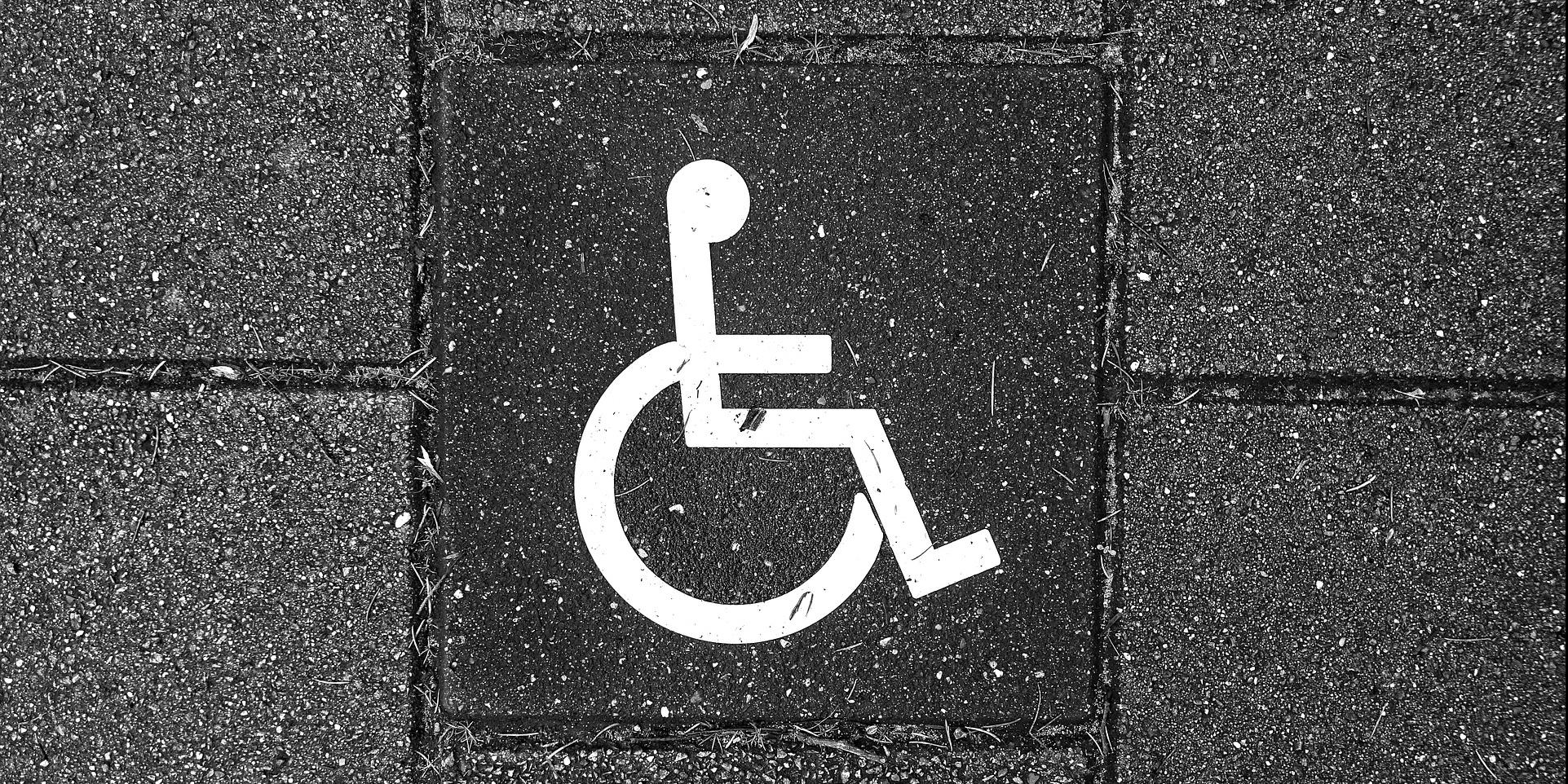
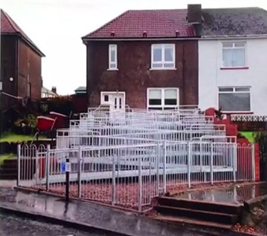
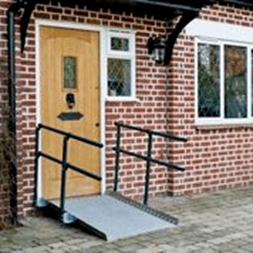
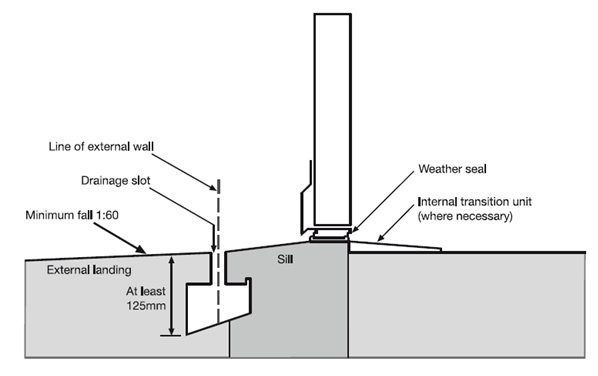
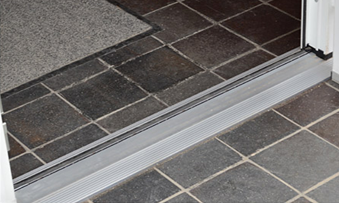



Comments
3 properties in need of new retro fit ramps
Submitted 2 years 5 months ago
We need two threshold addressing at a property in Birmingham, a custom ramp for a external office in Nottingham, and finally a ramp for the main entrance in Kidderminster.
Am I able to arrange quotes for these, please?
Kind regards,
LABC Response
Submitted 2 years 4 months ago
Thank you for your enquiry.
LABC is a membership organisation, providing advice and support to its member local authorities around England and Wales. We would recommend that you contact the relevant Local Authority Building Control teams directly for quotations.
You can find each Building Control team’s contact details by clicking the following link and entering your postcode into the search box at the top of the page: Local Authority Building Control | LABC | Building control.
Best,
LABC Team
Claim for disable ramp
Submitted 2 years 3 months ago
LABC Response
Submitted 2 years 2 months ago
Thank you for your enquiry, LABC advises on general matters relating to the Building Regulations, you would need to contact your particular LA to see if they provide grants for disabled facilities and or adaptations.
Kind regards,
LABC Team
Access through a front door stepped or ramp
Submitted 1 year 8 months ago
What is available
LABC Response
Submitted 1 year 6 months ago
Best,
LABC Team
Add new comment